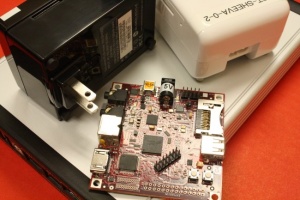From Fedora Project Wiki
(Add link to snapshot images) |
|||
| Line 30: | Line 30: | ||
= Releases = | = Releases = | ||
* Fedora 17 - Includes kernels for Tegra 2, OMAP, IMX, and Qemu systems. | * Fedora 17 - Includes kernels for Tegra 2, OMAP, IMX, and Qemu systems. | ||
** [http://blc.fedorapeople.org/fedora-arm/f17/ Current Snapshots ] including xzcat-able images. Unofficial, updated every few days. | |||
** [http://fedora.roving-it.com/rootfs-f17-hfp-alpha1.tar.bz2 Fedora 17 Alpha 1 release for ARMv7hl] (Optimized for Beagle, Panda, Trimslice, Efika and other ARMv7 devices) | ** [http://fedora.roving-it.com/rootfs-f17-hfp-alpha1.tar.bz2 Fedora 17 Alpha 1 release for ARMv7hl] (Optimized for Beagle, Panda, Trimslice, Efika and other ARMv7 devices) | ||
** [http://fedora.roving-it.com/rootfs-f17-sfp-alpha1.tar.bz2 Fedora 17 Alpha 1 release for ARMv5tel] (For use with legacy ARMv5 devices such as the Raspberry Pi, Guruplug and Dreamplug) | ** [http://fedora.roving-it.com/rootfs-f17-sfp-alpha1.tar.bz2 Fedora 17 Alpha 1 release for ARMv5tel] (For use with legacy ARMv5 devices such as the Raspberry Pi, Guruplug and Dreamplug) | ||
Revision as of 18:43, 23 April 2012

Examples of ARM develoment systems, including a SheevaPlug (white box), GuruPlug (black box), BeagleBoard (bare PCB), and OpenRD-Client (silver box). These systems typically consume under 5 watts each.
Introduction
ARM chips are the most widely-produced processor family in the world; they have historically been used in cell phones and embedded applications, and are increasingly used in tablet devices and low-power-consumption servers.
The Fedora-ARM project is an initiative to bring Fedora to this processor family.
Communication
- Mailing list: arm@lists.fedoraproject.org (archives)
- IRC: #fedora-arm on Freenode
Meetings
Planning
Resources
Detailed information on Fedora-ARM:
- Running Fedora-ARM on your ARM device, or through emulation on your PC
- Fedora ARM Koji (package builder) instance
- Information for Fedora package maintainers on getting your packages to work on ARM
- Information for Fedora-ARM team members (and prospective team members!) plus developers
- How to get an armv5tel cross toolchain installed on your x86 Fedora host
- How to build a kernel and cross-compile for ARM
- Building and Installing a Fedora Kernel Package on ARM Systems
- Various tips and hacks to improve Fedora ARM performance
Releases
- Fedora 17 - Includes kernels for Tegra 2, OMAP, IMX, and Qemu systems.
- Current Snapshots including xzcat-able images. Unofficial, updated every few days.
- Fedora 17 Alpha 1 release for ARMv7hl (Optimized for Beagle, Panda, Trimslice, Efika and other ARMv7 devices)
- Fedora 17 Alpha 1 release for ARMv5tel (For use with legacy ARMv5 devices such as the Raspberry Pi, Guruplug and Dreamplug)
- Fedora 16 - Was not released.
- Fedora 15 - Original armv5tel ABI and new faster armv7hl ABI
- Fedora 14 - For ARMv5tel
- Fedora 13 - For ARMv5tel
- Fedora 12 - For ARMv5tel
Development
- F17 (Work in progress)
- Fedora 15: Complete, but notes below for reference.
- Fedora 15 Hardware Floating Point Bootstrap
- Building F15 in koji - progress and outstanding tasks
